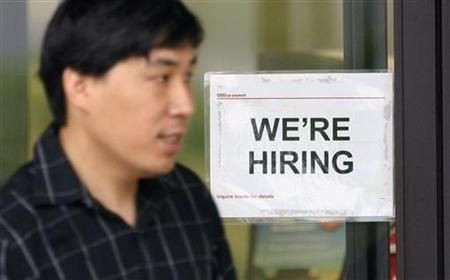It’s hiring stupid! Adding 200,000 jobs a month is the real test

The fall in initial jobless claims in the U.S. to the lowest level since July 2008 is not a right pointer to a possible labor market recovery, according to an analyst, who says the true test for the economy is the creation of anything above 200,000 payroll jobs in a month.
Initial jobless claims dropped last week by 34,000 to 407,000, the Labor Department reported on Wednesday. But labor market conditions have to improve a lot more and generate upwards of an average 50,000 jobs a month to significantly reduce the unemployment rate, Paul Dales, economist at Capital Economics, wrote in a note.
Our econometric model suggests that payroll employment increased by around 130,000 in November. That would be consistent with other evidence showing that labour market conditions have yet to improve by enough to reduce the unemployment rate significantly. We continue to believe that the unemployment rate will remain above 9% for at least the next two years.
Private payroll employment rose 159,000 employment in October, which was the largest gain April. Though this gave rise to hope that employment would soon start to grow by the 200,000 per month necessary to reduce the unemployment rate considerably. However, a month later payroll employment numbers dipped to 130,000.
Dales points out that the last time private payroll employment rose by 200,000 was between January 2005 and April 2006.
At its November meeting, the U.S. Federal Reserve lowered the GDP growth forecast to 2.4 per cent to 2.5 per cent this year and three per cent to 3.6 per cent in 2011, as it estimated that unemployment will remain stubbornly high in the medium term.
The Fed's projection that unemployment was unlikely to go below 9.5 per cent this year and 8.9 per cent in 2011 doesn’t paint a rosy picture for 15 million Americans looking out for jobs. As of October the unemployment rate was 9.6 percent, marking 18 months in which the jobless rate stayed at 9.4 percent or above.
Dales points out that what depresses the job market is the slow pace of hiring and not any spurt in firing. He says that five of the six indicators suggest that hiring conditions are weaker now than they were in 2005/06. The employment index of the ISM manufacturing survey is the only one that's above the 2005/06 average. Even that's not much of a consolation when manufacturing payrolls have fallen in each of the three months to October.
Fed policy makers announced a fresh round of quantitative easing, or asset purchase program, in November, aiming to boost liquidity and fight a slide into deflation.
Data released by the Commerce Department on Wednesday showed that personal spending rose 0.4 percent in October, marking a slight uptick in households' appetite for purchases even as a holiday season was kicking in. The rise in consumer confidence was well supported by a similar rise in personal incomes in the month, which rose 0.5 percent.
The trend of sequential rise in consumption is bullish on the GDP growth, but analysts have noted that the growth is still not strong enough and that the spending data justifies the Fed's QE2 program.
Dales says that the prospect of a robust economic recovery, which is strong enough to catapult job creation to the above-200,000 levels seen before the start of the crisis, is pretty unlikely. We doubt that the economy will be strong enough to warrant such a hiring spree anytime soon. The lingering uncertainty over the outlook for taxes, healthcare and financial reform won't help either, the analyst wrote.
© Copyright IBTimes 2024. All rights reserved.



















